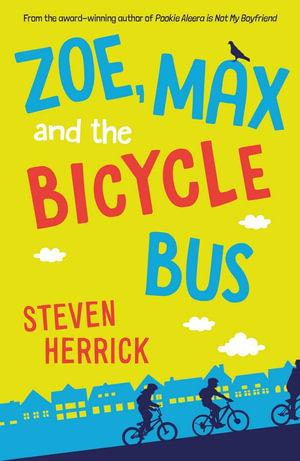How many of these Steven Herrick books have you read?


Great News!
Zoe, Max and the Bicycle Bus by Steven Herrick is on both the Premier's and Wyvern Reading Challenges. When we have finished reading this novel, it can be added to your Booklist Section on your Reading Log.
Premier's PCR ID 750939


I was born in Brisbane on New Years Eve, 1958. While everyone celebrated the New Year, Mum was left holding the baby. I was the youngest of seven children - Mum wanted a girl. She got me instead. I went to Coopers Plains State School, where I was good at English and soccer, and where I got punched in the eye by a girl one year older than me - I ran home!
From the age of eight to fifteen I was obsessed with soccer - I spent every spare moment kicking a ball against the house, or trying to knock the branches off trees from twenty metres with a well-aimed right foot drive. At Acacia Ridge High School I decided to concentrate on a life of soccer instead of education, so I failed Year 10. The principal suggested I not return for Year 11, so I didn't. I worked instead - fruit picker, storeman, clerk. And I played soccer on the weekend - still dreaming of football glory.
After three years of hard work and no chance of making the FA Cup Final at Wembley, I decided to go back to school as an adult. This time I passed all my subjects and went to university. At uni I studied poetry and chose poetry as a career. I now live in Katoomba in the Blue Mountains with my wife Cathie and our two children Jack and Joe.
Zoe, Max and the Bicycle Bus by Steven Herrick is a verse novel. But what is a verse novel, you may ask.
Verse novels are an extraordinary way to read a story. The entire story is written in verse–rather than prose. Prose are usually what fiction books are written in. That means the story is told in sentences which become paragraphs then pages and turn into chapters. In a verse novel the story is told through poems–rhyming or not, it doesn’t matter. Each turn of the page leads to poetry. The rhythm of verse novels becomes hypnotic making this type of book a very quick read.
When you first pick up a verse novel, you’ll probably think it’s a collection of poems. People often ask, if the way to read it, is to just to dip in and out.
The answer is no, because, just like a prose novel, a verse novel tells a story, so you need to start at the beginning and read through to the end. Someone once suggested that a reading a verse novel is like reading a lot of tiny chapters, which is a great description.
You will find that it is both a fast and a slow read. Sounds weird? A verse novel might have between 40 and 100 poems, of which many will be quite short. So you could read a verse novel quite quickly if you wanted to.
But because a poem can pack in so much more in terms of images and ideas and suggesting things to think about, it can take a while. Many readers like to read all the way through for the story, then read again and take the time to think about all the things the poems create in their imagination.
Often, the poems in a verse novel can’t stand alone. Although there are some poems in various verse novels that have been published in magazines on their own, in Zoe, Max and the Bicycle Bus, most of the poems are strongly linked into the storyline and don’t have as much meaning out of their context.
Verse novels are often easier to read than a chapterbook of the same length. They have a lot of white space and not too many words on each page. Even though the poetic form might look a bit intimidating, most verse novels aren’t written using elaborate language, so they’re usually easy to understand. Plus, verse novels tell stories and focus on specific characters’ experiences, so they’re a good taste of poetry for kids who prefer novels.
These are some of the characteristics of a Verse Novel.
1. Hybrid Form: A series of short, individual poems linked by topic, character, and plot.
2. White Space: The reader is left room to fill in the space on the page with association of their creation.
3. Chronological Order: The reader is encouraged to move sequentially through the text, rather than skip around.
4. Intense Internal Focus: The action centres on an emotional event, and the rest of the novel deals with the characters' feelings before and after.
By telling a story using poetry, you can enhance the emotional impact and create empathy with the reader. The novel-in-verse format also makes it easy to use literary techniques like similes and metaphors, giving more depth to the story.

With their new teacher’s help, the kids in Class 5D ride to school together in a bicycle bus. Olivia can fix a puncture in two minutes and Max can ride on one wheel. Lily wishes she wasn’t quite so wobbly and Jordi’s been waiting forever to ride on the road. Dylan has a speedy getaway from alley cats, Dabir’s glad to be part of a group and Zoe’s bike even has a name (Esmeralda). Everyone loves their new way of getting to school.
But there’s a narrow stretch on Fishers Road with no white line to separate the cyclists from the local traffic, so Zoe and Max decide they need to make it right (even if that means breaking a few rules).
Great News!
Zoe, Max and the Bicycle Bus is part of both the Wyvern and Premier's Reading Challenge. Once you have finished reading it, be sure to add it to your Reading Challenge Log.
Premier's Reading Challenge ID Number: 750939
Steven Herrick uses poetic devices in his book, Zoe, Max and the Bicycle Bus, such as personification, onomatopoeia, similes, metaphors, alliteration, imagery, repetition, rhyme and rhythm in his writing, but what are they?
Personification - attributing human characteristics to abstract ideas
Onomatopoeia - using words that imitate the sound they denote
Similes - a figure of speech expressing a resemblance between things
Metaphors - a figure of speech that suggests a non-literal similarity
Alliteration - use of the same consonant at the beginning of each word
Imagery - the ability to form mental pictures of things or events
Repetition - the act of doing or performing again
Rhyme - correspondence in the final sounds of two or more lines
Rhythm - an interval during which a recurring sequence occurs
Each week after completing your reading of Zoe, Max and the Bicycle Bus, choose one of the following prompts to complete your Reading Reflection sheet.
1. Read the section Poetic Devices in the Lib Guide. Choose and identify an example of one of these Poetic Devices from your reading today.
2. Make a prediction as to what will happen next in the story.
3. Choose a page from today's reading that stood out to you. Write the page number first. Why did this page stand out to you?
4. Write a question that you have about Zoe, Max and the Bicycle Bus after reading part of the story today.
5. Choose one of the main characters. Explain two things you have learned about them giving evidence from the story.
6. Finish this sentence. Today's reading was important to the storyline because..............
7. Think about the reading today. Can you make a connection to yourself, or the wider world or another text you have read. Choose one to use to write your prompt.
8. A Japanese philosophy states that ‘The children are taught independence … and it’s the community’s job to keep them safe’. How does this relate to the events and themes in Zoe, Max and the Bicycle Bus? Give an example to support your answer.
9. Write a reflection about Mr Bertoldi, sharing your understanding into his character. If you had to choose a person who most resembles Mr Bertoldi in your life, who would it be? Why?
10. Which is your favourite character in Zoe, Max and the Bicycle Bus? Why? Which do you most relate to? Why do you relate to this character?